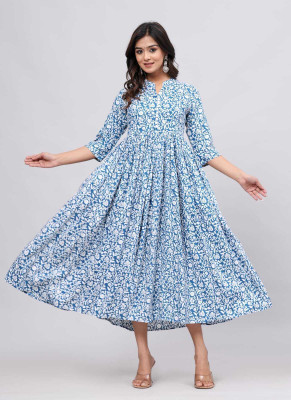poojaclothing Flared/A-line Gown(Blue, White)
Quick Overview
Product Price Comparison
Sanganeri Kurti, Anarkali Kurti, Chinkenkari Anarkali, and Jaipuri Anarkali Kurti are all different styles of traditional Indian ethnic wear that have distinct characteristics. Let's explore each of them:Sanganeri Kurti:Origin: Sanganer is a town in Rajasthan, India, known for its traditional block-printing techniques.Features: Sanganeri Kurtis typically feature intricate and vibrant block prints. These prints often include floral patterns, geometrical shapes, and traditional motifs. The color palette is usually rich and vibrant, reflecting the cultural aesthetics of Rajasthan.Anarkali Kurti:Origin: Named after Anarkali, a legendary dancer in the Mughal court, the Anarkali Kurti draws inspiration from Mughal-era fashion.Features: Anarkali Kurtis are characterized by their long, frock-style silhouette with a fitted bodice and a flared, floor-length skirt. They often feature intricate embroidery, zari work, or other embellishments around the neckline, sleeves, and hem. The Anarkali style is known for its graceful and flowy appearance.Chikankari Anarkali:Origin: Chikankari is an embroidery style that originated in Lucknow, India, and is known for its delicate and intricate white threadwork on lightweight fabrics.Features: Chikankari Anarkali Kurtis showcase the Chikankari embroidery technique, which involves hand-embroidered floral and geometric patterns using white cotton thread on fabrics like muslin or chiffon. The embroidery adds a touch of elegance and sophistication to the Anarkali silhouette.Jaipuri Anarkali Kurti:Origin: Jaipur, the capital city of Rajasthan, is famous for its rich cultural heritage and vibrant textiles.Features: Jaipuri Anarkali Kurtis often incorporate the traditional art and craft of Jaipur, such as block prints, tie-dye (Bandhej), and vibrant colors. These Kurtis may have mirror work, gota patti (metallic lace), or other embellishments that are characteristic of Rajasthani fashion.In summary, each of these Kurti styles has its own unique charm and reflects the rich cultural and artistic traditions of different regions in India. The choice of a particular style depends on individual preferences, occasions, and the desire to embrace specific regional aesthetics.


